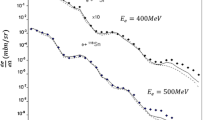Abstract
The algorithms and basic equations of a novel evaporation model that have been implemented in the program package EVAP15 are detailed. The level density of an excited nucleus is described by the composite Gilbert–Cameron formula with parameter values as suggested by the IAEA working group RIPL-3. Special attention is paid to the cross sections of inverse reactions and, in particular, to those for the interactions of low-energy neutrons with nuclei and for crossing of the Coulomb barrier by low-energy charged particles. The model predictions are compared with a large volume of experimental data on the spectra of particles emitted in the reactions (n, xn), (n, xp), and (n, xα) induced by neutrons with energy near 14 MeV and on the four spectra for the reaction (p, xp) induced by 62-MeV protons.
Similar content being viewed by others
References
V. F. Weisskopf and D. H. Ewing, “On the yield of nuclear reactions with heavy elements,” Phys. Rev. 57, 472–485 (1940).
G. Audi and A. H. Wapstra, “The 1995 update to the atomic mass evaluation,” Nucl. Phys. A 595, 409–480 (1995). https://www-ndsiaeaorg/amdc/masstables/Ame1995/
I. Dostrovsky, Z. Fraenkel, and G. Friedlander, “Monte Carlo calculations of nuclear evaporation processes. III. Application to low-energy reactions,” Phys. Rev. 116, 683–702 (1959).
S. Furihata, “Statistical analysis of light fragment production from medium energy proton-induced reactions,” Nucl. Instrum. Methods Phys. Res. B 171, 252–258 (2000).
A. Gilbert and A. G. W. Cameron, “A composite nuclear-level density formula with shell corrections,” Can. J. Phys. 43, 1446–1496 (1965).
https://www-ndsiaeaorg/RIPL-3/
A. V. Sannikov and E. N. Savitskaya, “Physics of the HADRON code: recent status and comparison with experiment,” Nucl. Instrum. Methods Phys. Res. A 450, 127–137 (2000).
wwwnndcbnlgov/exfor/exforhtm
A. V. Ignatyuk, K. K. Istekov, and M. N. Smirenkin, “Collective effects in level density and the probability of fission,” Sov. J. Nucl. Phys. 30, 626 (1979).
W. D. Myers and W. J. Swiatecki, “Nuclear masses and deformation,” Nucl. Phys. 81, 1–60 (1966).
A. Mengoni and Yu. Nakajima, “Fermi-gas model parametrization of nuclear level density,” J. Nucl. Sci. Eng. 31, 151–162 (1994).
A. S. Iljinov, M. V. Mebel, N. Bianchi, E. de Sanctis, C. Guaraldo, V. Lucherini, V. Muccifora, E. Polli, A. R. Reolon, and P. Rossi, “Phenomenological statistical analysis of level densities, decay widths and time lives of excited nuclei,” LNF-91/058(P) (Frascati, 1991).
V. S. Barashenkov, “Cross section of interaction of particle and nuclei with nuclei,” Preprint JINR (Dubna, 1993).
ftp://ftpnrgeu/pub/www/talys/tendl2012/tendl2012html
P. Kirkby and W. T. Link, “Faraday-cup measurement of proton total reaction cross sections,” Can. J. Phys. 44, 1847–1862 (1966).
C. Kalbach, “Toward a global exciton model; lessons at 14 MeV,” J. Phys. G: Nucl. Part. Phys. 24, 847–866 (1998)
A. J. Koning, S. Hilaire, and M. Duijvestijn, TALYS1.2: A Nuclear Reaction Program, User Manual (Petten, 2009).
wwwnndcbnlgov/exfor/endf00jsp.
https://www-ndsiaeaorg/RIPL-2/optical/om-data/totelasysreadme
wwwnndcbnlgov/ensdf/
http://cernlibwebcernch/cernlib/
A. V. Sannikov and E. N. Savitskaya, “Total nucleonnucleus reaction cross sections calculated in the frame of the cascade model,” Radiat. Prot. Dosim. 110, 27–31 (2004).
A. V. Sannikov and E. N. Savitskaya, “Generalized cascade model of nucleus reactions,” in Proceedings of the 9th Russian Scientific Conference on Radiation Protection and Radiation Safety in Nuclear Technologies, Obninsk, 2006, pp. 276–281.
Author information
Authors and Affiliations
Corresponding author
Additional information
Original Russian Text © A.V. Sannikov, E.N. Savitskaya, 2016, published in Pis’ma v Zhurnal Fizika Elementarnykh Chastits i Atomnogo Yadra, 2016.
Rights and permissions
About this article
Cite this article
Sannikov, A.V., Savitskaya, E.N. A statistical model for simulating the emission of light particles from excited nuclei. Phys. Part. Nuclei Lett. 13, 318–335 (2016). https://doi.org/10.1134/S1547477116030183
Received:
Published:
Issue Date:
DOI: https://doi.org/10.1134/S1547477116030183




